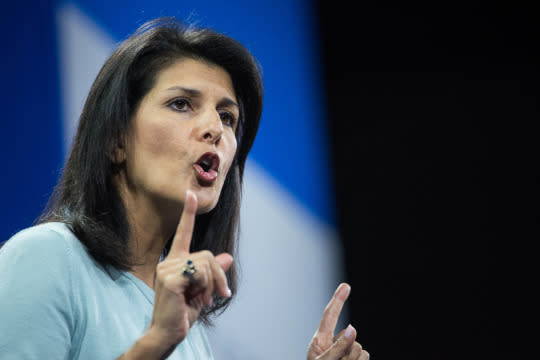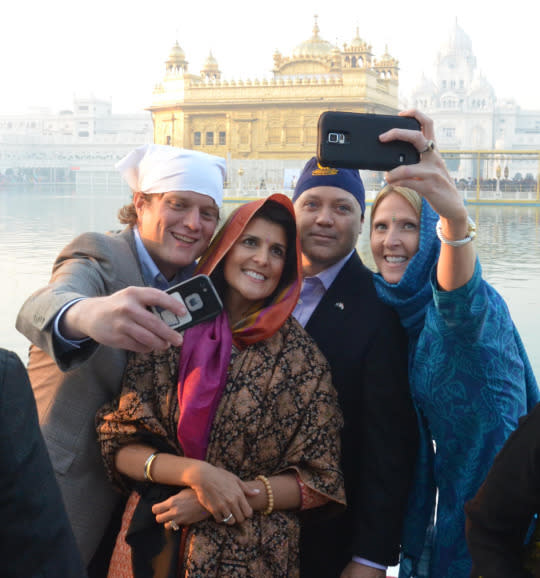Nikki Haley is the opposite of Donald Trump. That’s why she’s delivering this year’s SOTU response.

South Carolina Gov. Nikki Haley speaks at the Kemp Forum in Columbia, S.C., in January. (Photo: Sean Rayford/AP)
Every year, the president of the United States comes to the House of Representatives, stands behind the speaker’s rostrum, and delivers his State of the Union address — and every year, the opposing party selects one of its rising stars to appear on live TV immediately afterward and respond.
The point of these responses is to make your party look good and the president look bad. But this year’s response may be different.
That’s because the GOP has picked South Carolina Gov. Nikki Haley to deliver it. There’s no doubt that Haley will criticize Barack Obama’s policies, just as she’s been doing since she first took office in 2011.
But she seems to have been selected to make someone other than the president look bad as well: her own party’s indomitable frontrunner, Donald J. Trump.
It’s hard not to think that when Haley, widely touted as a potential vice presidential nominee, was offered the gig in early December by newly minted House Speaker Paul Ryan — a man who has vowed to transform the GOP into “an agenda party, a solutions party, an ideas party, so that we make our case not based on personality, but based on ideas to the country” — the congressman and his allies were trying to send a message about The Donald.
Haley, 43, is the opposite of Trump is almost every way. He is a senior citizen. She is the youngest governor in the country. He is white. She is the daughter of Indian immigrants. He is a New Yorker. She comes from a small town in South Carolina. He is a political opportunist. She is a tea party conservative. He is a he. She is a she.
And while Trump has recently fashioned himself into America’s principal avatar of right-wing intolerance, demonizing Mexicans, Muslims, and Megyn Kelly, among others, Haley has emerged as a lonely symbol of Republican inclusiveness, leading the charge in the wake of June’s Charleston church massacre to remove the Confederate flag from the South Carolina state capitol and denouncing Trump’s divisive rhetoric on numerous occasions since then.
“Every time someone criticizes him, he goes and makes a political attack,” Haley said when asked about Trump during an appearance at the National Press Club in September. “That’s not who we are as Republicans. That’s not what we do.”

Haley and her husband, Michael, pose for a selfie with fans at the Golden Temple in Amritsar, India. (Photo: Sameer Sehgal/Hindustan Times via Getty Images)
Born Nimrata Nikki Randhawa in Bamberg, S.C., on Jan. 20, 1972, Haley is no stranger to bias and bigotry. When her parents arrived from India’s Punjab state three years earlier — her father, a biology professor, wrapped his long hair in the traditional Sikh turban; her mother, a lawyer, wore a sari — they found that no one was willing to rent them a house.
“We were the first Indian family ever to live in Bamberg,” Haley wrote in her 2012 memoir, “Can’t Is Not an Option.” “In a time and place that only knew black and white, we didn’t fit either category.”
It was a lesson that Haley learned early on. At the age of 5, she entered a “Little Miss Bamberg” pageant with her sister. There were typically two winners: a black queen and a white queen. The judges let the Randhawas perform — then disqualified them because they were brown.
“We don’t have a place for you,” they explained.
In kindergarten, Haley’s teachers cast her as Pocahontas in the school play — a turn, she recalled in her memoir, that “marked the beginning of a long parade of little boys dancing around me and doing the American Indian hand-to-mouth call.”
A few years later, the rest of Haley’s classmates divided themselves into two groups at recess — one black, the other white.
“Are we playing [kickball] today?” Haley asked.
“We are,” one girl said. “You’re not.”
“Why?” Haley asked.
“You have to pick a side,” the girl replied. “Are you white or are you black?”
Haley began working for her mother’s clothing business at an early age and eventually received an accounting degree from Clemson University. But it wasn’t until she decided to run for the state House in 2004 that she realized how insidious the bigotry that she had first encountered as a kid could be.
Haley’s rival, incumbent Larry Koon, was the sort of guy who believed, as he once put it, that “women are best suited for secretarial work, decorating cakes and counter sales, like selling lingerie.” His campaign fliers featured his photograph on one side (“white male, Christian, business owner”) and Haley’s on the other (“Indian female, Buddhist, housekeeper”). (Never mind that Haley is a Christian.) Whenever the two candidates met on the trail, Koon made sure to call Haley “little lady”; he regularly reminded voters that her birth name was Nimrata Randhawa. Eventually Haley defeated Koons — the heavy favorite — by 10 percentage points.
Her underdog gubernatorial campaign was even more controversial. “We’ve got a raghead in Washington,” state Senator Jake Knotts said at one point, referring to President Obama. “We don’t need a raghead in the Statehouse.” A black Democrat referred to Haley as “a conservative with a tan.”
Gender was an issue as well. As soon as polls showed Haley in the lead, unsubstantiated rumors of extramarital affairs began to surface in the press — accusations that were “more believable in the eyes of some voters,” Haley wrote in her memoir, because “I was a young woman.” (Haley vowed to resign if the claims were validated, which they never were.)
Still, for most of her governorship — she won reelection in 2014 — Haley, true to her tea party reputation, was hardly a civil rights crusader. She refused to expand Medicaid coverage under the Affordable Care Act. She signed an Arizona-style immigration law forcing police officers to report anyone they suspected of being a noncitizen. She pushed for stricter enforcement of South Carolina’s E-Verify rules. And when she first took office, legislators immediately complained about her administration’s lack of diversity.
“At the end of the day, I had to show results as governor,” Haley wrote in her memoir. “I didn’t care what color the people were who helped me do that.”
Haley even opposed removing the Confederate battle flag from the grounds of the state capitol. During her initial run for governor, she said the flag was “not something that is racist,” but rather “a tradition that people feel proud of.”
Yet after 21-year-old white supremacist Dylann Roof shot and killed nine African-Americans at Charleston’s Emanuel African Methodist Episcopal Church during a June 17 prayer service, Haley’s views began to change.
“I’ve got some things in my head,” she texted her husband after seeing photos of Roof clutching the Confederate flag, “and I just need to know if I’m thinking right.”

Legislators applaud after Haley signs a bill to remove the Confederate battle flag from the Statehouse grounds. (Photo: Sean Rayford/Getty Images)
She had decided that the flag needed to come down. She met with members of both parties. She cried during a press conference. When legislation stalled in the House, Haley huddled with her fellow Republicans to make sure they understood what was at stake.
“I told them they had not heard me talk a lot about race,” she recently explained, “but I wanted them to know a story.”
One day, when Haley was 10, she convinced her father to let her drive with him to Columbia, the big city, about an hour away from home. On the way they stopped at a fruit stand. As her dad began to fill a bag with produce, Haley glanced at the register. The owners looked nervous. One of them picked up the phone. Moments later, a pair of police cars sped up to the stand. Even as a grade schooler, Haley realized that the cops were “there because of us.”
“I have to pass that farmer’s stand every time I go to the airport,” Haley told the Republicans. “And every time I pass it I feel pain.”
“The Statehouse belongs to everybody,” she continued. “No child should drive by the Statehouse and feel pain.”
The bill passed soon after.
When Trump ascended to the top of the GOP polls over the summer, Haley was one of the first Republicans to speak out against him. “We need to make sure that we’re always communicating in a way that’s got respect and dignity,” Haley said at the time. “When we saw all of this happen [in South Carolina], people respected each other. They may have disagreed, but they respected each other. That tone is important for the country. … A harsh tone … hurts people, and it’s just not necessary.”
Haley isn’t a moderate. She isn’t calling for new gun-control measures. She has pushed steep cuts to the state budget. She has sought to curb regulations and limit lawsuits. She is vehemently opposed to Obamacare. She is hostile to unions. And after the mass shooting in San Bernardino, Calif., she joined two dozen other governors in declaring that their states would not accept Syrian refugees.
But in the wake of the Charleston massacre, Haley has proven that she understands how to be a conservative without alienating everybody who isn’t a member of the GOP’s dwindling demographic base.
“I’m really excited about this,” Paul Ryan said Monday. “If you want to hear an inclusive leader who’s visionary, who’s got a path for the future, who’s brought people together, who’s unified, it’s Nikki Haley.”
For Ryan and other mainstream Republicans, Haley’s response Tuesday night represents an opportunity to show off the GOP as they hoped it would look before Trump hijacked 2016: younger, more diverse, and more consistently, thoughtfully conservative.
The question now is whether it’s too little too late.
Watch the State of the Union and the GOP response right here. Coverage and commentary hosted by Katie Couric begins at 8:45 pm Eastern.

